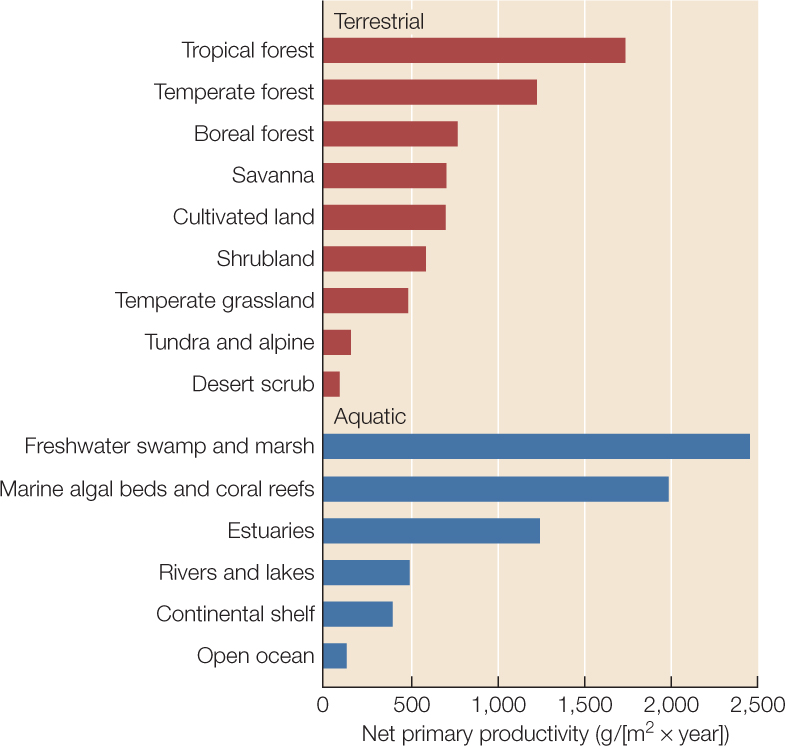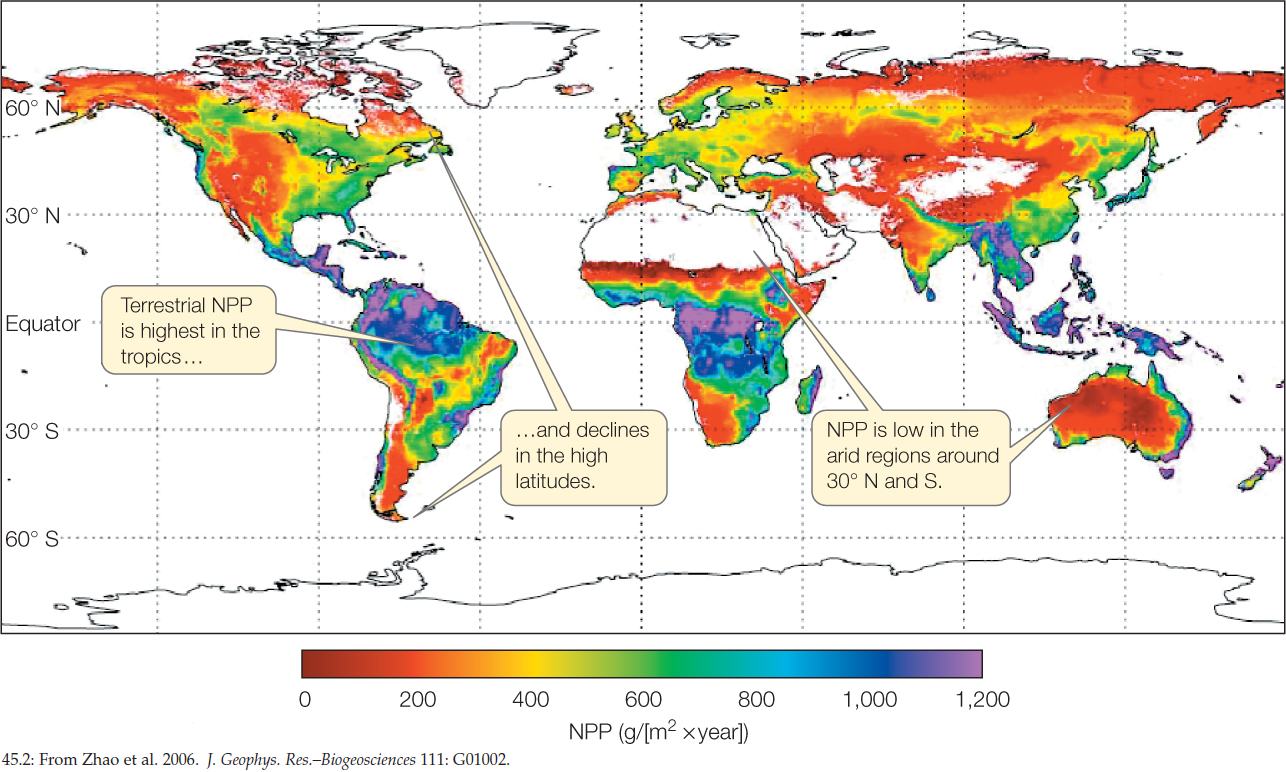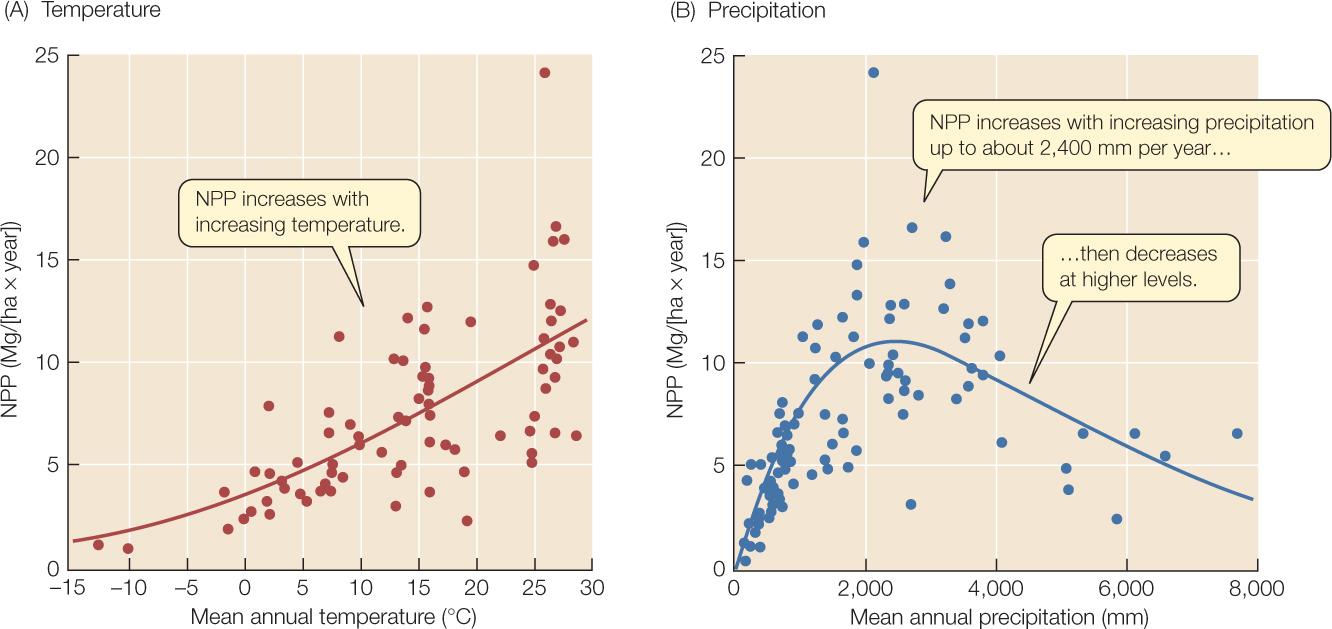Concept 45.1: Climate and Nutrients Affect Ecosystem Function-
As we learned in Concept 41.1, the term ecosystem is commonly applied to ecological communities plus the abiotic environments with which they exchange energy and materials. Most of the interactions among components of ecosystems happen at a local scale. A plant, for example, can absorb only those nitrate molecules that are in physical contact with its root hairs; an elk in Alberta cannot fall prey to a wolf living in Wyoming’s Yellowstone National Park; and a raindrop interacts directly only with the soil particles it contacts. For this reason, most studies of ecosystems are done at relatively small spatial scales, such as a single river drainage, lake, or patch of forest.
Local ecosystems are linked, however, by slower exchanges of organisms, energy, and materials that occur on spatial scales ranging from tens of kilometers within regional landscapes to thousands of kilometers around the planet. These long-distance interactions occur when organisms move among communities and when energy and materials are transported by the physical circulation of the atmosphere and the oceans, by flowing water, and by geological processes that occur below Earth’s crust. Large-scale patterns ultimately influence inputs to and losses from local ecosystems, making it impossible to understand a local ecosystem completely without considering it in the context of the larger systems of which it is a part. This chapter therefore takes both local and global perspectives.
NPP is a measure of ecosystem function
Ecosystems, like other biological systems (see Concept 1.2), can be characterized by their components and by patterns of interaction among those components. In ecosystem studies, the community as a whole is often treated as one component, and distinct portions of the abiotic environment, such as soil, atmosphere, or water, are treated as other components. The dynamic processes by which these components exchange and transform energy and materials are aspects of ecosystem function.
Ultimately, movements of materials between the abiotic and biotic components of ecosystems are tied to carbon. Primary producers combine inorganic carbon dioxide with inorganic water to make organic carbohydrates. Energy stored in the chemical bonds of those molecules fuels the synthesis of all the biomass in the bodies of organisms at every trophic level (see Concept 6.2). Most of the elemental constituents of that biomass enter communities through the primary producers as well. Calcium in the bones of a wolf, for example, came from the elk it ingested; the elk obtained calcium from the plants it ate; and the plants used energy from the breakdown of carbohydrates to extract inorganic calcium from the soil.
The rate at which a community makes primary producer biomass—its net primary productivity, or NPP (see Concept 44.3)—is therefore a measure of the flow of materials, as well as energy, into the biotic component of its ecosystem. This measure of ecosystem function does not incorporate all exchanges of materials between organisms and the abiotic environment: organisms, for example, also take in or excrete inorganic water or salts to maintain homeostasis. Such exchanges are nonetheless indirectly coupled with primary productivity because they are fueled by the energy that enters the community via primary producers.
Scientists are now able to estimate NPP with instruments, carried by orbiting satellites, that measure the reflection of different wavelengths of light by Earth’s surface. This “view from space” allows them to calculate how much sunlight is absorbed by chlorophyll in different regions and thus to map the distribution of photosynthetic biomass—which is correlated with NPP—across the planet. These maps show that NPP is not the same everywhere. As we will see next, patterns of variation in NPP indicate factors that limit ecosystem function.
NPP varies predictably with temperature, precipitation, and nutrients
Net primary productivity varies considerably among ecosystem types. Among terrestrial ecosystems, tropical forests are the most productive per unit of area, followed by temperate forests, whereas tundra and deserts are the least productive (FIGURE 45.1). Among aquatic ecosystems, freshwater swamps and marshes and marine algal beds and coral reefs are the most productive, followed by estuarine habitats, whereas the open ocean is the least productive. Much of this pattern derives from variation in climate and nutrient availability.

Satellite images of terrestrial ecosystems show that NPP varies with latitude: highly productive areas are concentrated in the tropics, and higher latitudes are less productive (FIGURE 45.2). This pattern parallels latitudinal gradients in solar energy input (see Figure 41.3) and temperature, suggesting that NPP increases with temperature. Indeed, terrestrial NPP generally does increase with temperature (FIGURE 45.3A), which makes sense when we consider that the activity of photosynthetic enzymes, like that of other enzymes, increases up to the critical temperature at which enzymes denature (see Concept 3.4). This critical temperature varies among plant species that are adapted to different environments but is usually about 40°C–50°C.


918
The satellite images also show areas of low terrestrial NPP at 30° N and S latitude (see Figure 45.2), where deserts occur (see Figures 41.5 and 41.11). This pattern parallels gradients in precipitation, suggesting that moisture also affects NPP. Terrestrial NPP does increase with precipitation up to about 2,400 millimeters per year, then decreases at higher levels (FIGURE 45.3B). This also makes physiological sense. Moist soil conditions facilitate water and nutrient uptake by roots and allow plants to maintain pressure within their cells without closing their stomata (leaf pores), thus facilitating CO2 uptake (see Concept 25.3). The decrease in NPP in extremely moist climates may result from increased cloud cover and lower solar input or from a lack of oxygen in water-saturated soils.
919
Finally, we also know that elements such as nitrogen, phosphorus, and potassium, which are critical for plant growth (see Figure 25.1), can be in short enough supply to limit NPP in both natural and agricultural ecosystems. Soils in southwestern Australia, for example, are nutrient-poor because most nutrients have been washed (leached) out of the soil over hundreds of millions of years, during which there has been no nutrientrenewing geological uplift. As we saw in Concept 41.3, many plants in this region do not allocate their scarce nitrogen to defensive compounds; instead, they allocate it to proteins that are essential for metabolism and growth.
LINK
The principle of allocation of resources is discussed in Concept 42.3
In aquatic ecosystems, NPP is affected more strongly by light and nutrients than by temperature. Photosynthesis is restricted to surface waters where light can penetrate (the photic zone; see Figure 41.13). As a result, NPP is generally higher in surface than in deep waters; the only productive deep-water areas are hydrothermal vents, where chemoautotrophs (see Concept 19.3) generate new biomass by using chemical energy rather than sunlight. But not all surface waters are productive. The open ocean, for example (see Figure 45.1), is unproductive because dissolved nutrients are often limited there—phytoplankton take up surface nutrients quickly and move them to deep waters when they (or the consumers that eat them) die and sink. Aquatic NPP is highest where nutrients are abundant—where rivers and streams discharge nutrients leached from terrestrial ecosystems into coastal marine areas, near-shore zones of lakes, and shallow freshwater wetlands (FIGURE 45.4). NPP is also high in areas of upwelling, where deep water from the bottom of an ocean or lake rises to the surface, bringing with it nutrients from benthic sediments.

CHECKpoint CONCEPT 45.1
- NPP is generally higher in freshwater wetlands (swamps and marshes) than in shallow marine waters (algal beds, coral reefs, and estuaries; see Figure 45.1). Why might this be so?
- Why do you think NPP in human-cultivated land is lower than that in several natural ecosystem types such as temperate and tropical forest? (See Figure 45.1. Hint: See Concept 44.3.)
- Outline an experiment that would allow you to determine whether NPP in a grassland ecosystem is limited by the availability of water in the soil.
We now have an overview of global patterns of ecosystem function, as measured by NPP, and some of the factors that cause them. We have seen that nutrient availability plays an important role in these patterns, which makes sense because nutrients are chemical elements that organisms require for their metabolism and as materials to build their bodies. What are the processes that affect the availability of nutrients?
920